Table of Contents
The UNESCO Sites in China have resulted from the recognition of 56 cultural and natural landmarks as UNESCO World Heritage Sites in China and 62 locations on the China UNESCO tentative list. These tourist sites in China are acknowledged for their unique and valuable cultural, natural, artistic, and historical significance and are preserved for future generations to enjoy.
In addition to these 56 sites on the China UNESCO list, there are many other places to travel to China that are being considered for UNESCO recognition. These sites, listed on the tentative list, showcase the rich cultural heritage of the country and are waiting for approval to join the prestigious and famous World Heritage Sites list.
To help visitors discover these remarkable China tourist attractions, we have put together an interactive map of the UNESCO sites in China.
China UNESCO Map
Click markers to show information and photo.
World Heritage Sites in China
UNESCO World Heritage Sites in China
There are 56 UNESCO World Heritage Sites in China. All of these three sites are listed under the Cultural category.
- Ancient Building Complex in the Wudang Mountains
- Ancient City of Ping Yao
- Ancient Villages in Southern Anhui – Xidi and Hongcun
- Archaeological Ruins of Liangzhu City
- Capital Cities and Tombs of the Ancient Koguryo Kingdom
- Classical Gardens of Suzhou
- Cultural Landscape of Honghe Hani Rice Terraces
- Dazu Rock Carvings
- Fujian Tulou
- Historic Centre of Macao
- Historic Ensemble of the Potala Palace, Lhasa
- Historic Monuments of Dengfeng in “The Centre of Heaven and Earth”
- Imperial Palaces of the Ming and Qing Dynasties in Beijing and Shenyang
- Imperial Tombs of the Ming and Qing Dynasties
- Kaiping Diaolou and Villages
- Kulangsu, a Historic International Settlement
- Longmen Grottoes
- Lushan National Park
- Mausoleum of the First Qin Emperor
- Mogao Caves
- Mount Qingcheng and the Dujiangyan Irrigation System
- Mount Wutai
- Mountain Resort and its Outlying Temples, Chengde
- Old Town of Lijiang
- Peking Man Site at Zhoukoudian
- Quanzhou: Emporium of the World in Song-Yuan China
- Silk Roads: the Routes Network of Chang’an-Tianshan Corridor
- Site of Xanadu
- Summer Palace, an Imperial Garden in Beijing
- Temple and Cemetery of Confucius and the Kong Family Mansion in Qufu
- Temple of Heaven: an Imperial Sacrificial Altar in Beijing
- The Grand Canal
- The Great Wall
- Tusi Sites
- West Lake Cultural Landscape of Hangzhou
- Yin Xu
- Yungang Grottoes
- Zuojiang Huashan Rock Art Cultural Landscape
- Chengjiang Fossil Site
- China Danxia
- Fanjingshan
- Huanglong Scenic and Historic Interest Area
- Hubei Shennongjia
- Jiuzhaigou Valley Scenic and Historic Interest Area
- Migratory Bird Sanctuaries along the Coast of Yellow Sea-Bohai Gulf of China
- Mount Sanqingshan National Park
- Qinghai Hoh Xil
- Sichuan Giant Panda Sanctuaries – Wolong, Mt Siguniang, and Jiajin Mountains
- South China Karst
- Three Parallel Rivers of Yunnan Protected Areas
- Wulingyuan Scenic and Historic Interest Area
- Xinjiang Tianshan
- Mount Emei Scenic Area, including Leshan Giant Buddha Scenic Area
- Mount Huangshan
- Mount Taishan
- Mount Wuyi
UNESCO World Heritage Sites in China are protected locations for their cultural and natural importance.
Ancient Building Complex in the Wudang Mountains

The Ancient Building Complex in the Wudang Mountains is a UNESCO World Heritage Site in China. This complex is situated in the scenic Wudang Mountains and is renowned for its historical and cultural significance. It includes a collection of ancient buildings and structures, such as palaces, temples, and martial arts training grounds, preserved for centuries. The architectural style reflects the unique harmony between nature and human creation, with intricate details and elegant designs. The Wudang Mountains are also known as the birthplace of influential Taoist martial arts and philosophy, making this site a pilgrimage destination for spiritual seekers and cultural enthusiasts.
Ancient City of Ping Yao
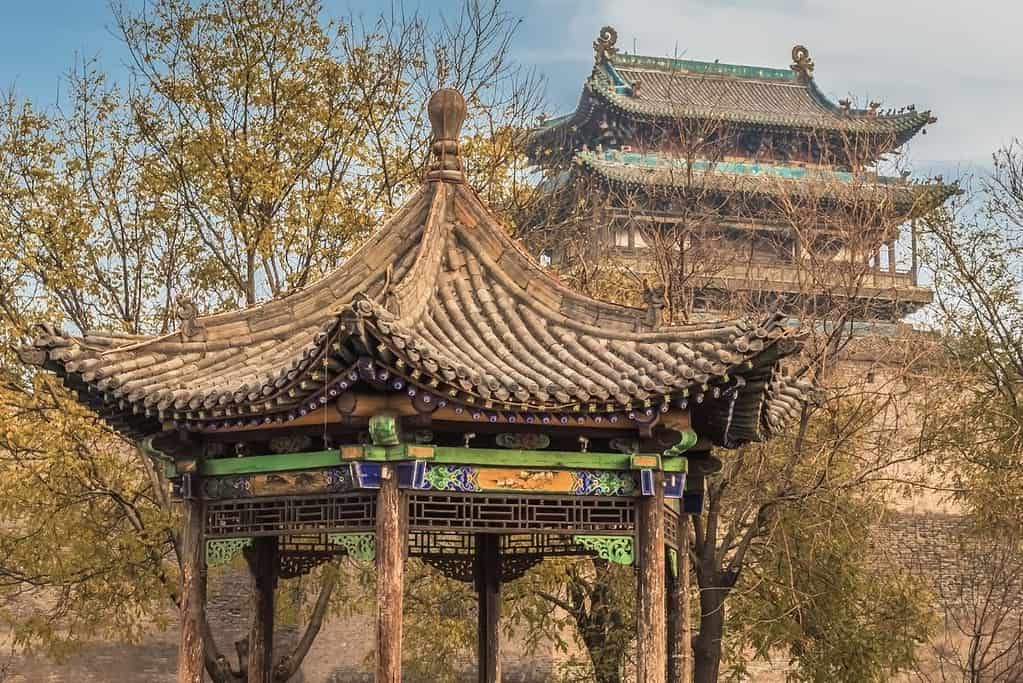
The Ancient City of Ping Yao is a UNESCO World Heritage Site in China. It is an exceptionally well-preserved example of a traditional Han Chinese city. The city dates back over 2,700 years and was a major financial center during the Ming and Qing dynasties. Its unique architecture, including its imposing city walls, temples, and traditional courtyard houses, reflects the prosperous history of the region. Walking through the narrow streets and alleys of Ping Yao is like stepping back in time, offering visitors a glimpse into ancient Chinese urban life and culture.
Ancient Villages in Southern Anhui – Xidi and Hongcun
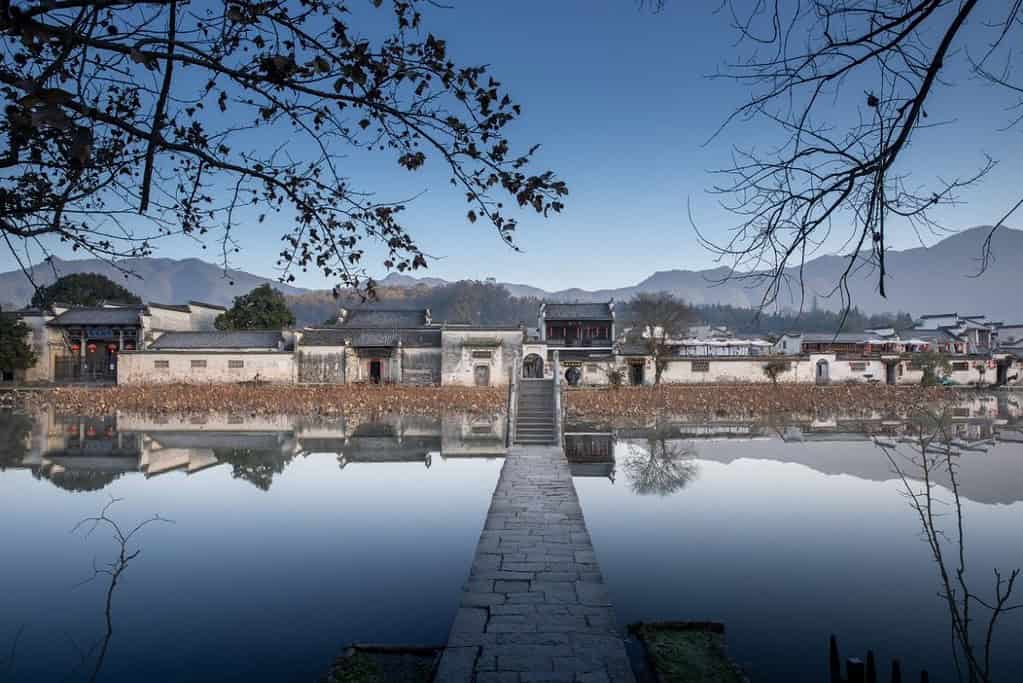
Ancient Villages in Southern Anhui – Xidi and Hongcun are UNESCO World Heritage Sites in the southern part of Anhui Province, China. These villages showcase the region’s rural communities’ traditional architecture and way of life. Xidi and Hongcun are renowned for their well-preserved Ming and Qing Dynasty buildings, featuring intricate wooden carvings, stone bridges, and peaceful waterways. The villages’ layout and design harmoniously blend with the surrounding natural landscapes, creating a picturesque setting. The ancient villages offer visitors a glimpse into China’s rich history, culture, and architectural heritage, making them a must-visit destination for history and culture enthusiasts.
Archaeological Ruins of Liangzhu City
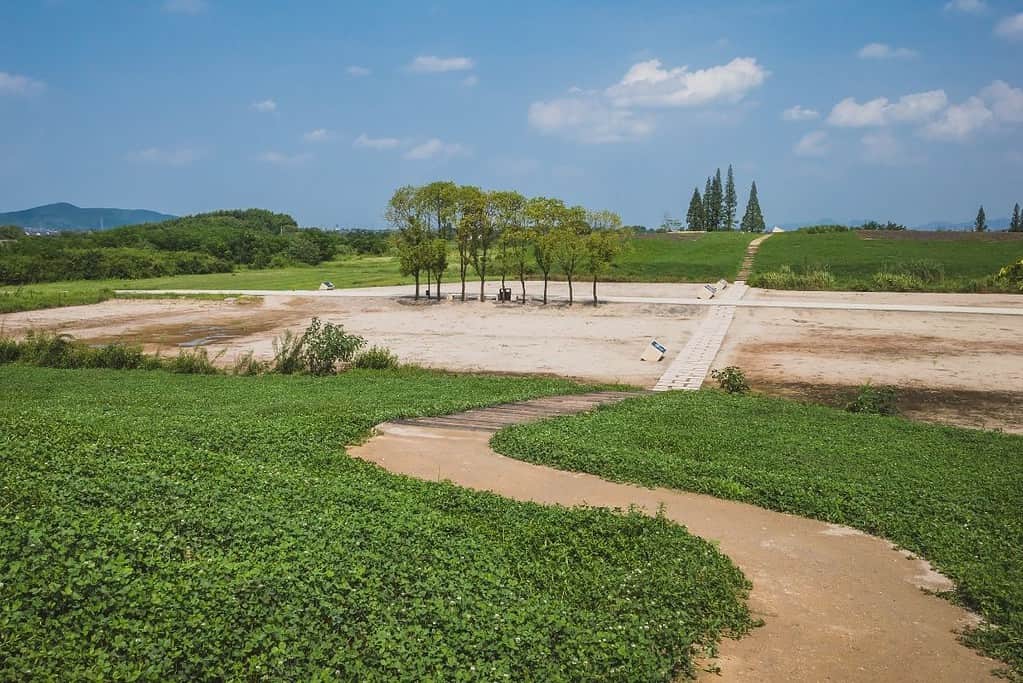
The Archaeological Ruins of Liangzhu City is a UNESCO World Heritage Site in China. These ruins represent the remains of a sophisticated ancient civilization that thrived over 5,000 years ago. The site showcases the well-preserved remnants of a prehistoric city, revealing the advanced urban planning, social organization, and cultural achievements of the Liangzhu culture. The archaeological findings include ceremonial sites, residential areas, water conservation systems, and elaborate jade artifacts, providing valuable insights into the early development of Chinese civilization. The Archaeological Ruins of Liangzhu City stands as a testament to the remarkable ingenuity and cultural significance of this ancient civilization.
Capital Cities and Tombs of the Ancient Koguryo Kingdom
The Capital Cities and Tombs of the Ancient Koguryo Kingdom is a UNESCO World Heritage Site located in North Korea and China. This site showcases the remains of the Koguryo Kingdom, a powerful dynasty from the 3rd century BC to the 7th century AD. The site includes three capital cities—Wunu Mountain City, Guonei City, and Wandu Mountain City—each featuring impressive architectural structures, fortifications, and tombs. These ancient remnants offer valuable insights into the political, cultural, and artistic achievements of the Koguryo Kingdom, making it a significant historical and cultural site of immense importance.
Classical Gardens of Suzhou

The Classical Gardens of Suzhou, a UNESCO World Heritage Site in China, is a remarkable testament to traditional Chinese garden design art. These gardens, dating back to the 11th century, showcase the harmonious blending of nature, architecture, and poetry. The gardens feature meticulously crafted landscapes, with elegant pavilions, meandering waterways, serene ponds, and delicate bridges. Each garden within the site is designed to evoke a different mood and tell a unique story. Visitors can immerse themselves in these timeless gardens’ tranquility and experience their profound beauty and cultural significance.
Cultural Landscape of Honghe Hani Rice Terraces

The Cultural Landscape of Honghe Hani Rice Terraces is a UNESCO World Heritage Site in Yunnan Province, China. This breathtaking landscape showcases the traditional agricultural practices of the Hani ethnic minority, who have cultivated rice on these terraces for over 1,300 years. The intricate terraces, built into the steep slopes of the mountains, create a stunning mosaic of lush green fields that cascade down the valleys. The site represents a remarkable feat of engineering and showcases the harmonious coexistence between humans and nature. The Hani people’s sustainable farming techniques and deep cultural connection to the land make the Honghe Hani Rice Terraces a unique and culturally significant destination.
Dazu Rock Carvings

The Dazu Rock Carvings is a UNESCO World Heritage Site in Chongqing, China. It is renowned for its exceptional collection of ancient rock carvings that date back to the 9th century. These intricate carvings depict Buddhist, Confucian, and Taoist religious scenes, historical events, and daily life in ancient China. The Dazu Rock Carvings are known for their artistic quality, detail, and harmonious integration of the carvings with the natural landscape. This site serves as a testament to China’s rich cultural and religious heritage, attracting visitors from around the world who appreciate its historical significance and artistic beauty.
Fujian Tulou

Fujian Tulou is a remarkable UNESCO World Heritage Site in the Fujian Province of China. These unique earthen structures are traditional rural dwellings built by the Hakka and Minnan communities. Fujian Tulou showcases exceptional architectural and cultural significance, characterized by their circular or rectangular shapes, sturdy construction, and harmonious integration with the surrounding natural landscape. These fortified buildings, often housing multiple families, served as communal living spaces and provided defense against external threats. The intricate design and cultural heritage preserved within Fujian Tulou make it a captivating destination for visitors seeking to explore China’s rich history and architectural marvels.
Historic Centre of Macao

The Historic Centre of Macao is a UNESCO World Heritage Site in Macao, China. It represents the unique fusion of Chinese and Western cultures, resulting from centuries of exchange and coexistence. The historic center showcases the rich architectural legacy of Macao, with its narrow streets, vibrant squares, and well-preserved buildings. It features outstanding examples of colonial-era structures, such as the Ruins of St. Paul’s, which represent Macao’s historical significance as a trading port. The blending of Chinese temples, Portuguese churches, and other cultural landmarks within the cityscape create a captivating atmosphere highlighting Macao’s rich multicultural heritage.
Historic Ensemble of the Potala Palace, Lhasa

The Historic Ensemble of the Potala Palace in Lhasa, Tibet, is a UNESCO World Heritage Site of great cultural and historical significance. Perched atop the Red Hill, this majestic palace complex served as the winter residence of successive Dalai Lamas and the political center of Tibetan Buddhism. With its distinctive Tibetan architectural style, the Potala Palace boasts towering walls, ornate golden roofs, and intricate murals that depict Tibetan religious and cultural heritage. The palace complex consists of numerous halls, chapels, and sacred spaces, including the remarkable Red Palace and the White Palace. As a symbol of Tibetan identity and spirituality, the Potala Palace attracts visitors worldwide, offering a glimpse into the rich heritage and grandeur of Tibetan civilization.
Historic Monuments of Dengfeng in “The Centre of Heaven and Earth”

The Historic Monuments of Dengfeng in “The Centre of Heaven and Earth” is a UNESCO World Heritage Site in China. This site represents Chinese religious, philosophical, and martial arts traditions, encompassing a cluster of renowned temples, religious buildings, and cultural landmarks. At the heart of this site is the famous Shaolin Temple, renowned for its association with Zen Buddhism and the birthplace of martial arts. Other monuments within the complex include the Zhongyue Temple, the Songyang Academy, and the Taishi Que Terrace. These historic treasures beautifully reflect the rich cultural heritage of Dengfeng and serve as a significant pilgrimage site for those seeking spiritual enlightenment and appreciation of China’s ancient traditions.
Imperial Palaces of the Ming and Qing Dynasties in Beijing and Shenyang

The Imperial Palaces of the Ming and Qing Dynasties in Beijing and Shenyang are UNESCO World Heritage Sites in China. These magnificent palaces showcase the architectural grandeur and historical significance of the Ming and Qing dynasties. In Beijing, the Forbidden City symbolizes imperial power and consists of numerous palaces, halls, and gardens. It’s intricate design and ornate decorations leave visitors in awe of the imperial lifestyle. In Shenyang, the Mukden Palace impresses with its blend of Chinese and Manchu architectural styles, offering a glimpse into the rich heritage of the Qing dynasty. These imperial palaces are remarkable testimonies to China’s rich cultural and historical legacy.
Imperial Tombs of the Ming and Qing Dynasties

The Imperial Tombs of the Ming and Qing Dynasties is a UNESCO World Heritage Site in China. This site is a collection of mausoleums and burial complexes that served as the final resting places for emperors, empresses, and other members of the royal families during the Ming and Qing dynasties. These tombs are renowned for their grandeur and architectural significance, showcasing the traditional Chinese imperial burial customs and artistic achievements of the time. Each tomb complex is carefully designed with intricate detailing, including ceremonial paths, beautiful gardens, and magnificent structures like the Sacred Way and the Hall of Eminent Favor. The Imperial Tombs provide a fascinating glimpse into China’s imperial history and cultural heritage.
Kaiping Diaolou and Villages

Kaiping Diaolou and Villages is a UNESCO World Heritage Site in Kaiping, China. This remarkable site showcases a unique blend of Chinese and Western architectural styles, reflecting the region’s rich history and cultural exchange. The main highlight of the site is the Diaolou, fortified multi-story watchtowers built in the late 19th and early 20th centuries. These Diaolou served as defensive structures and homes for local families. The villages surrounding the Diaolou feature traditional Chinese rural architecture, with well-preserved ancestral halls, temples, and communal buildings. This exceptional combination of architectural styles and cultural heritage makes Kaiping Diaolou and Villages a captivating destination for visitors interested in history, architecture, and cultural diversity.
Kulangsu, a Historic International Settlement
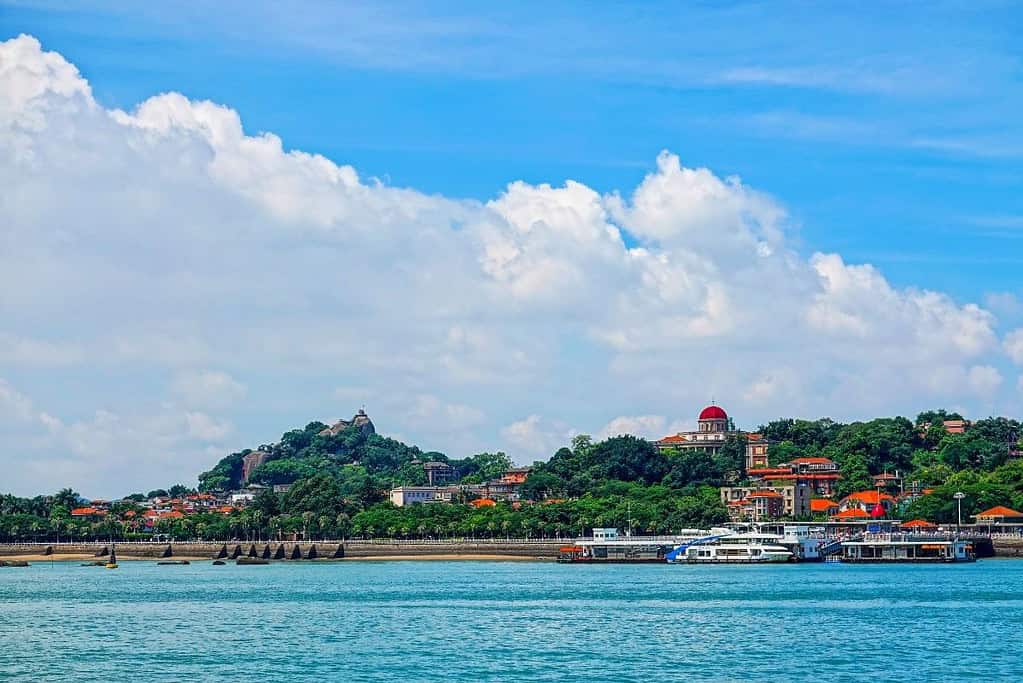
Kulangsu, a Historic International Settlement, is a UNESCO World Heritage Site in China. It is a small, car-free island known for its rich cultural heritage and unique architectural styles. The settlement was established in the 19th century as an international trading port and became a melting pot of various cultures and influences. The island is home to an impressive collection of Western-style mansions, churches, and public buildings, blending Chinese and foreign architectural elements. Visitors to Kulangsu can explore its charming streets, visit museums, and experience the vibrant music scene, making it a must-visit destination for history and culture enthusiasts.
Longmen Grottoes

The Longmen Grottoes, a UNESCO World Heritage Site located in China, is an extraordinary testament to the artistic and cultural achievements of the Tang Dynasty. The site is near Luoyang and comprises thousands of caves and niches adorned with intricate Buddhist rock-cut sculptures. Carved into the limestone cliffs along the banks of the Yi River, the grottoes feature over 100,000 statues of varying sizes, including colossal Buddha figures reaching heights of up to 17 meters. These masterpieces showcase remarkable craftsmanship, depicting a fusion of Chinese and Indian artistic traditions. The Longmen Grottoes is an awe-inspiring representation of ancient China’s rich heritage and profound spiritual devotion.
Lushan National Park
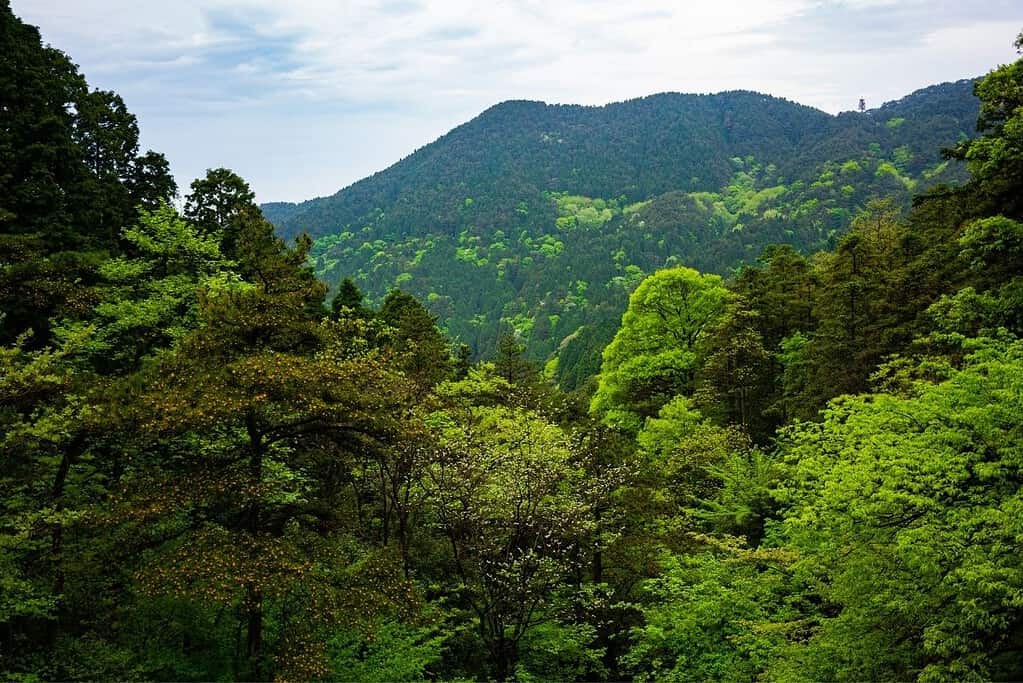
Lushan National Park is a UNESCO World Heritage Site in Jiangxi Province, China. This stunning nature reserve is renowned for its breathtaking landscapes, encompassing majestic mountains, deep valleys, and picturesque waterfalls. The park is home to various flora and fauna, including rare and endangered species. Lushan’s rich cultural heritage is also evident through its ancient temples, pavilions, and historical sites throughout the park. Visitors can explore the enchanting beauty of Lushan National Park while immersing themselves in its tranquil atmosphere and experiencing the harmony between nature and human history.
Mausoleum of the First Qin Emperor

The Mausoleum of the First Qin Emperor is a UNESCO World Heritage Site in China. It is renowned for being the burial site of Qin Shi Huang, the first Emperor of China. Constructed over 2,000 years ago, the mausoleum is an extraordinary architectural and archaeological marvel. It is famously known for its terracotta army, an army of life-sized clay soldiers, horses, and chariots buried to protect the emperor in the afterlife. The mausoleum complex reflects the grandeur and power of the Qin Dynasty and is a testament to ancient China’s remarkable craftsmanship and historical significance.
Mogao Caves

The Mogao Caves, a UNESCO World Heritage Site, are in Dunhuang, China. These ancient Buddhist caves are renowned for their exceptional collection of Buddhist art and manuscripts, spanning over a thousand years of history. The caves were carved into the cliffside and housed around 500 preserved cave temples. Visitors can marvel at the intricate murals, statues, and painted scrolls depicting Buddhist deities, religious scenes, and daily life from different dynasties. The Mogao Caves are a testament to ancient China’s rich cultural heritage and artistic mastery.
Mount Qingcheng and the Dujiangyan Irrigation System

Mount Qingcheng and the Dujiangyan Irrigation System is a UNESCO World Heritage Site in China. It is a remarkable testament to ancient engineering and harmonious coexistence with nature. Mount Qingcheng is a sacred Taoist mountain renowned for its lush greenery and serene atmosphere. It is considered one of the birthplaces of Taoism and features numerous temples, pavilions, and ancient pathways. The Dujiangyan Irrigation System, on the other hand, is an ingenious water management system that has been in operation for over 2,000 years. It effectively harnesses the power of the Minjiang River to irrigate the surrounding farmland, prevent floods, and supply water to Chengdu, one of China’s oldest cities. Mount Qingcheng and the Dujiangyan Irrigation System showcase the ingenuity and wisdom of ancient Chinese civilization.
Mount Wutai

Mount Wutai, located in Shanxi Province, China, is a UNESCO World Heritage Site of immense cultural and spiritual significance. Revered as one of the Four Sacred Mountains of Buddhism, Mount Wutai is a major pilgrimage site for Buddhists worldwide. “Five Terraces” refers to the five flat mountain peaks that dominate the landscape. The mountain is adorned with numerous ancient monasteries, temples, and pagodas, showcasing exquisite Buddhist architecture and art. These sacred structures and the natural beauty of the surrounding landscapes create a serene and awe-inspiring atmosphere that continues to attract visitors seeking spiritual enlightenment and cultural enrichment.
Mountain Resort and its Outlying Temples, Chengde
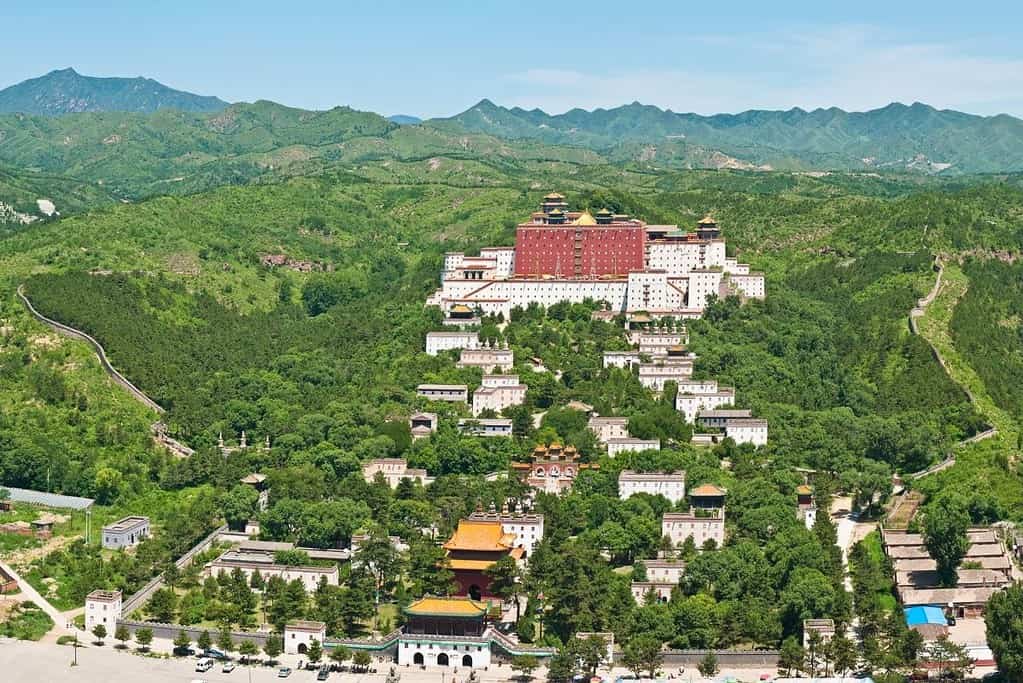
Mountain Resort and its Outlying Temples, Chengde, is a UNESCO World Heritage Site in China. It is a remarkable complex that combines natural beauty with cultural and historical significance. The Mountain Resort, the Chengde Imperial Summer Resort, was a retreat for Chinese emperors during the Qing Dynasty. Set amidst a picturesque landscape, it features a vast array of pavilions, palaces, gardens, and lakes, showcasing exquisite Chinese architectural styles. The site also includes a collection of outlying temples representing various Buddhist, Taoist, and Mongolian influences. This harmonious blend of nature and human creation makes the Mountain Resort and its Outlying Temples a captivating destination for visitors and a testament to China’s rich cultural heritage.
Old Town of Lijiang
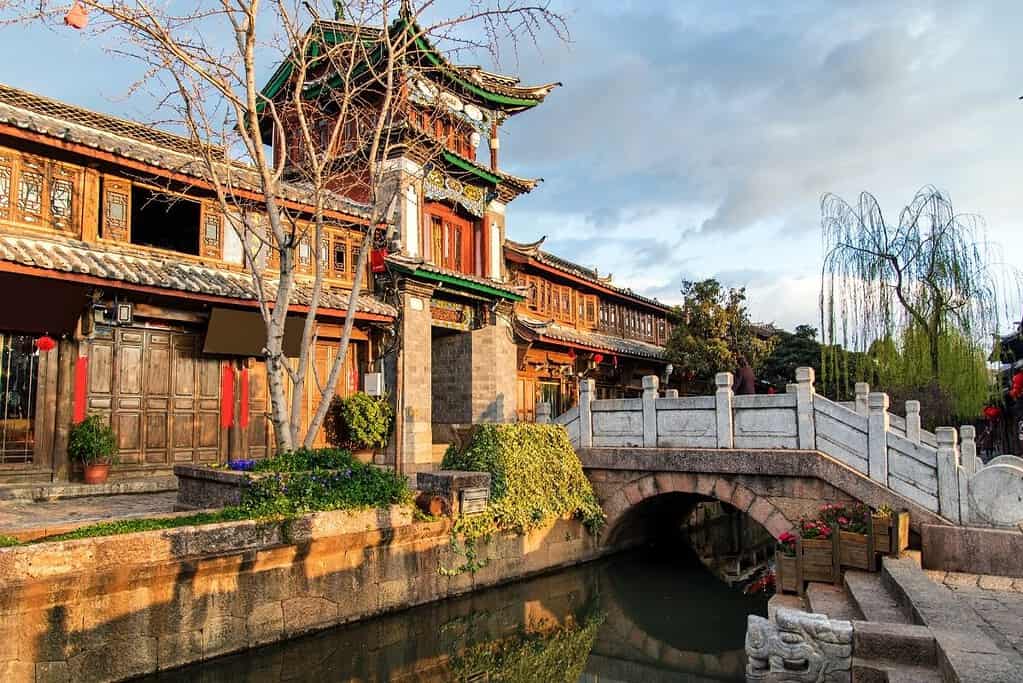
The Old Town of Lijiang, a UNESCO World Heritage Site, is a charming and picturesque destination in Yunnan Province, China. This historic town is renowned for its well-preserved ancient architecture, winding cobbled streets, and beautiful canals. The unique blend of traditional Naxi culture and influences from various ethnic groups can be seen in the vibrant local customs, traditional music, and colorful festivals. The Old Town’s distinct wooden houses, intricately carved stone bridges, and tranquil courtyards create a captivating atmosphere, transporting visitors back in time. Exploring the narrow alleys and bustling market squares, visitors can immerse themselves in Lijiang’s rich history and cultural heritage while enjoying breathtaking views of the surrounding snow-capped mountains.
Peking Man Site at Zhoukoudian

The Peking Man Site at Zhoukoudian is a UNESCO World Heritage Site near Beijing, China. It is a significant archaeological site that has provided valuable insights into human evolution. The site preserves the remains and artifacts of Homo erectus, also known as Peking Man, who inhabited the area approximately 750,000 years ago. Excavations at Zhoukoudian have unearthed fossilized remains of ancient humans, stone tools, and evidence of fire use, shedding light on our understanding of early human history and cultural development. This remarkable site offers a fascinating glimpse into our ancestral past and the evolution of human civilization.
Quanzhou: Emporium of the World in Song-Yuan China

Quanzhou, known as the “Emporium of the World,” is a UNESCO World Heritage Site in Song-Yuan China. This historic city was a thriving maritime trade hub during the Song and Yuan dynasties, connecting China with the rest of the world. Quanzhou’s strategic location along the maritime Silk Road made it a melting pot of cultures and religions, with influences from China, the Middle East, and Southeast Asia. The city boasts a rich architectural heritage featuring magnificent temples, mosques, and pagodas that reflect its multicultural past. Today, visitors can explore the ancient streets, visit the well-preserved historical sites, and immerse themselves in Quanzhou’s fascinating history and vibrant atmosphere, a testament to its once prominent role in international trade and cultural exchange.
Silk Roads: the Routes Network of Chang’an-Tianshan Corridor
The Silk Roads: the Routes Network of Chang’an-Tianshan Corridor is a UNESCO World Heritage Site located in China, Kazakhstan, and Kyrgyzstan. This corridor encompasses a network of ancient routes that were once vital for trade and cultural exchange between East and West. It played a significant role in connecting civilizations and fostering the exchange of goods, ideas, and technologies. The site features numerous archaeological sites, historic cities, ancient fortifications, and other cultural landmarks that showcase the rich history and diverse cultural heritage of the Silk Roads. It stands as a testament to the enduring impact of these routes on global history and the interconnectedness of civilizations.
Site of Xanadu
Xanadu, the renowned UNESCO World Heritage Site, is a captivating destination located in Inner Mongolia, China. This ancient city holds great historical significance as it was the capital of Kublai Khan’s Yuan Dynasty during the 13th century. The site showcases a fascinating blend of Mongolian and Chinese architectural styles, offering visitors a glimpse into the grandeur and opulence of the past. As you explore Xanadu, you will encounter stunning palace ruins, intricate temples, and impressive city walls that once surrounded the bustling metropolis. The harmonious integration of nature and man-made structures in Xanadu’s serene surroundings adds to its allure, making it a must-visit for history enthusiasts and cultural explorers.
Summer Palace, an Imperial Garden in Beijing

The Summer Palace is a magnificent UNESCO World Heritage Site in Beijing, China. It is an imperial garden that showcases the grandeur and beauty of traditional Chinese architecture and landscaping. Nestled amidst Kunming Lake and Longevity Hill, the Summer Palace is renowned for its exquisite pavilions, halls, bridges, and gardens, all meticulously designed to harmonize with the natural surroundings. The palace’s centerpiece, the stunning Marble Boat, stands as a symbol of opulence and extravagance. Visitors can stroll through the enchanting halls, explore the intricately decorated temples, and enjoy breathtaking panoramic views of the lake and surrounding landscapes. The Summer Palace embodies imperial China’s rich history, cultural significance, and aesthetic brilliance.
Temple and Cemetery of Confucius and the Kong Family Mansion in Qufu

The Temple and Cemetery of Confucius and the Kong Family Mansion in Qufu is a UNESCO World Heritage Site in Qufu, China. This site holds great cultural and historical significance as it honors the life and teachings of Confucius, one of the most influential philosophers in Chinese history. The Temple of Confucius serves as a place of worship and tribute to Confucius. At the same time, the Kong Family Mansion is a remarkable architectural complex that was the residence of his descendants, the Kong family. The site also includes the Cemetery of Confucius, which contains elaborate tombstones and burial grounds. This UNESCO site provides a fascinating glimpse into the life and legacy of Confucius and is a cherished cultural landmark in China.
Temple of Heaven: an Imperial Sacrificial Altar in Beijing

The Temple of Heaven in Beijing, China, is a UNESCO World Heritage Site and an iconic symbol of ancient Chinese architecture. Built during the Ming Dynasty, it served as an imperial sacrificial altar where emperors would pray for good harvests and offer sacrifices to heaven. The temple complex comprises several exquisite buildings, including the Hall of Prayer for Good Harvests, the Circular Mound Altar, and the Imperial Vault of Heaven. With its magnificent design, intricate details, and serene surroundings, the Temple of Heaven is a testament to China’s rich cultural and religious heritage.
The Grand Canal

The Grand Canal, a UNESCO World Heritage Site, is a remarkable waterway located in China. Spanning over 1,700 kilometers, it connects Beijing in the north to Hangzhou in the south, passing through several major cities and picturesque landscapes. With a history of over 1,400 years, the Grand Canal served as a vital transportation route and played a significant role in China’s economic and cultural development. Its construction involved remarkable engineering achievements, including impressive locks, bridges, and the famous Gongchen Bridge. Today, the Grand Canal is a testament to ancient Chinese civilization’s ingenuity and enduring legacy.
The Great Wall

The Great Wall of China, a UNESCO World Heritage Site, is an iconic symbol of China’s rich history and remarkable engineering prowess. Spanning over 13,000 miles (21,196 kilometers), it is one of the world’s most extensive and well-preserved ancient defense systems. Built over centuries, the Great Wall was a formidable barrier against invasions and protected the Chinese Empire. Its grandeur and scale, with imposing watchtowers and fortified walls snaking across mountains and valleys, offer a breathtaking testament to human ingenuity and determination. Today, the Great Wall is a testament to China’s cultural heritage. It attracts visitors from around the globe who come to marvel at its magnificence and immerse themselves in its extraordinary history.
Tusi Sites

The Tusi Sites are a UNESCO World Heritage Site located in China. This cultural landscape includes three separate sites: the Tusi (local tribal leader) sites of Tangya, Hailongtun, and Yongshun. These sites showcase the unique governance system of the Tusi ethnic minorities during the Ming and Qing dynasties. The Tusi system allowed local leaders to exercise political and military control over their regions while still acknowledging the authority of the central Chinese government. The Tusi Sites feature well-preserved architectural structures, including palaces, temples, ancestral halls, and fortifications, which provide valuable insights into the history and cultural traditions of the Tusi people. It is a fascinating destination for those interested in exploring China’s rich heritage and diverse ethnic groups.
West Lake Cultural Landscape of Hangzhou

The West Lake Cultural Landscape of Hangzhou is a UNESCO World Heritage Site in Hangzhou, China. It is renowned for its breathtaking natural beauty and profound cultural significance. The landscape features the stunning West Lake, surrounded by lush hills, pagodas, temples, and historic gardens. This harmonious blend of nature and human creativity has inspired countless poets, artists, and scholars throughout history. The West Lake Cultural Landscape reflects the profound influence of Chinese garden design and embodies traditional Chinese culture’s philosophical and aesthetic ideals. It is a captivating destination that continues to captivate visitors with its serene beauty and rich cultural heritage.
Yin Xu
Yin Xu, a UNESCO World Heritage Site located in China, is a significant archaeological site that offers a glimpse into the ancient Shang Dynasty civilization. Situated near Anyang City, Yin Xu was the capital of the Shang Dynasty and served as a political, economic, and cultural hub over 3,000 years ago. The site showcases remarkable remnants of palace foundations, royal tombs, bronze workshops, and oracle bone inscriptions, providing valuable insights into the early Chinese civilization. Yin Xu stands as a testament to the rich history and cultural legacy of the Shang Dynasty, offering visitors a captivating journey back in time.
Yungang Grottoes
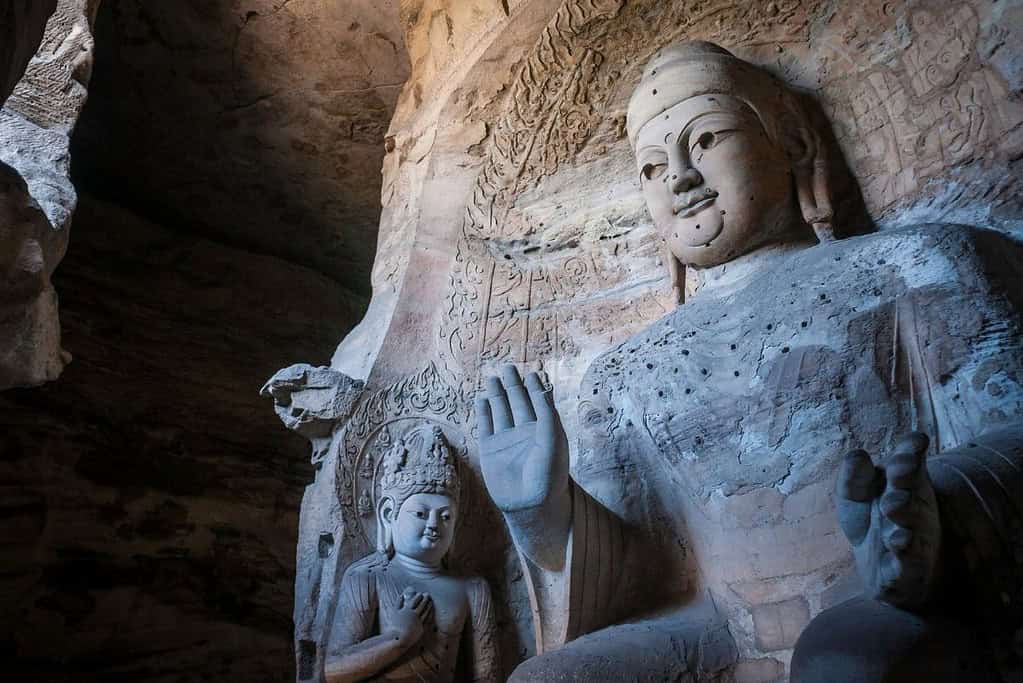
The Yungang Grottoes is a UNESCO World Heritage Site in Datong, China. It is an exceptional collection of ancient Buddhist cave temples and rock-cut sculptures dating back to the 5th century. The grottoes comprise 252 caves with over 51,000 statues, making it one of the world’s most impressive Buddhist art sites. These sculptures showcase the time’s intricate craftsmanship and artistic talent, depicting various Buddhist figures, deities, and scenes from Buddhist scriptures. The Yungang Grottoes are a testament to China’s rich cultural and religious history and a captivating destination for visitors seeking to explore the beauty and significance of ancient Buddhist art.
Zuojiang Huashan Rock Art Cultural Landscape
Zuojiang Huashan Rock Art Cultural Landscape is a captivating UNESCO World Heritage Site in China. Nestled within the karst landscape of Guangxi Zhuang Autonomous Region, this cultural treasure boasts extraordinary rock art that dates back thousands of years. The site features over 200 cliffside caves adorned with vibrant paintings and intricate engravings depicting scenes of daily life, hunting, and rituals of ancient civilizations. These remarkable artworks offer invaluable insights into prehistoric communities’ cultural and artistic traditions, making Zuojiang Huashan Rock Art Cultural Landscape a fascinating destination for history and art enthusiasts.
Chengjiang Fossil Site
The Chengjiang Fossil Site is a remarkable UNESCO World Heritage Site in China. It is renowned for its exceptional preservation of fossils from the Cambrian period, approximately 520 million years ago. The site provides valuable insights into the early evolution of complex life forms on Earth. Scientists have discovered many well-preserved and diverse organisms within the Chengjiang Fossil Site, including the early ancestors of today’s arthropods and chordates. The fossils found here have contributed significantly to our understanding of the Cambrian explosion and have been instrumental in unraveling the mysteries of ancient marine ecosystems. The Chengjiang Fossil Site stands as a remarkable testament to our planet’s early stages of life’s development.
China Danxia

China Danxia is a UNESCO World Heritage Site located in China. It is renowned for its unique and breathtaking landscapes, characterized by colorful, towering sandstone landforms. These mesmerizing formations have been shaped over millions of years through the forces of nature, including erosion, uplift, and weathering. The vibrant hues of the rock layers, ranging from reds and oranges to yellows and greens, create truly magical and picturesque scenery. China Danxia is a testament to the incredible geological processes that have shaped our planet and stands as a testament to the awe-inspiring beauty of nature.
Fanjingshan

Fanjingshan, located in Guizhou Province, China, is a UNESCO World Heritage Site of exceptional natural and cultural significance. Rising majestically above the clouds, Fanjingshan is renowned for its breathtaking landscapes and unique biodiversity. The mountain is home to diverse ecosystems, including ancient forests, rare plant species, and endemic wildlife such as the endangered Guizhou snub-nosed monkey. At its summit stands the iconic Red Clouds Golden Peak, an awe-inspiring rock formation that has been a pilgrimage site for centuries. With its rich natural beauty and spiritual significance, Fanjingshan captivates visitors with its serene tranquility and profound cultural heritage.
Huanglong Scenic and Historic Interest Area

Huanglong Scenic and Historic Interest Area is a UNESCO World Heritage Site in China. This remarkable area is renowned for its stunning natural beauty and significant cultural value. It features colorful pools, cascading waterfalls, and unique limestone formations that create a breathtaking landscape. The site is also home to diverse flora and fauna, including endangered species. In addition to its natural wonders, Huanglong boasts historical and cultural treasures, such as ancient temples and shrines, with great religious significance. Visitors to Huanglong are treated to a captivating blend of natural splendor and rich heritage, making it a must-visit destination for nature lovers and history enthusiasts.
Hubei Shennongjia

Hubei Shennongjia, located in the Hubei province of China, is a UNESCO World Heritage Site renowned for its exceptional natural beauty and rich biodiversity. This stunning region is characterized by its vast forests, deep gorges, and picturesque landscapes, making it a paradise for nature enthusiasts. Hubei Shennongjia is home to many rare and endangered plant and animal species, including the iconic golden snub-nosed monkey. Exploring this unique site allows visitors to immerse themselves in the untouched beauty of ancient forests and experience the harmony between humans and nature.
Jiuzhaigou Valley Scenic and Historic Interest Area

Jiuzhaigou Valley Scenic and Historic Interest Area is a UNESCO World Heritage Site in southwestern China. It is renowned for its breathtaking natural beauty and rich cultural heritage. The valley is characterized by its vibrant turquoise lakes, majestic waterfalls, snow-capped peaks, and lush forests, creating a picturesque landscape that captivates visitors worldwide. Apart from its stunning natural features, Jiuzhaigou Valley is home to several Tibetan villages, ancient temples, and sacred sites, reflecting the region’s deep-rooted cultural traditions. The area is a haven for biodiversity, harboring numerous rare and endangered species. Jiuzhaigou Valley is a true gem that offers a harmonious blend of awe-inspiring scenery, cultural significance, and ecological importance.
Migratory Bird Sanctuaries along the Coast of Yellow Sea-Bohai Gulf of China

The Migratory Bird Sanctuaries along the Coast of the Yellow Sea-Bohai Gulf of China is a UNESCO World Heritage Site in China. This site is a crucial habitat for numerous migratory bird species that travel along the East Asian-Australasian Flyway. Spanning across the coastline of the Yellow Sea and Bohai Gulf, the sanctuaries provide essential resting and feeding grounds for millions of birds during their long-distance migrations. The site’s diverse ecosystems, including intertidal mudflats, marshes, and sandy beaches, support a rich biodiversity and serve as a vital link in the migratory routes of these birds. The conservation of this site is of global significance, ensuring the survival and well-being of countless avian species.
Mount Sanqingshan National Park
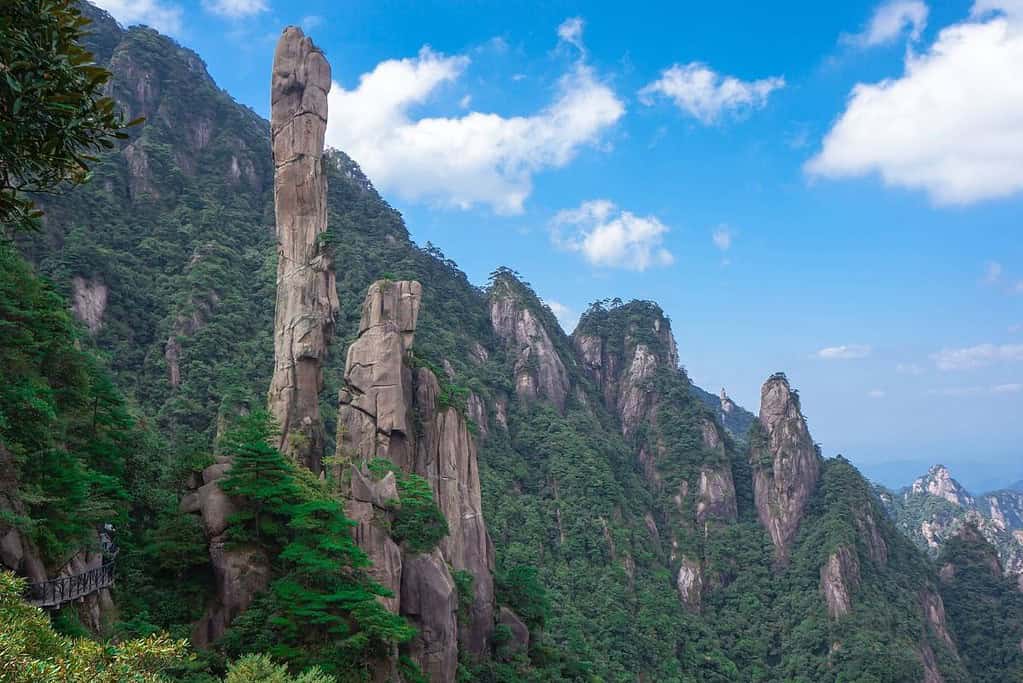
Mount Sanqingshan National Park is a UNESCO World Heritage Site located in China. It is renowned for its breathtaking natural beauty and unique granite rock formations. The park is home to Mount Sanqingshan, considered one of China’s most sacred mountains. Its mist-shrouded peaks, deep valleys, and lush forests create a picturesque landscape that attracts visitors worldwide. The park is a haven for nature lovers and holds great cultural significance, with numerous temples and ancient structures among its scenic wonders. Mount Sanqingshan National Park offers an enchanting blend of natural splendor and cultural heritage, making it a must-visit destination for those seeking awe-inspiring beauty.
Qinghai Hoh Xil

Qinghai Hoh Xil is a UNESCO World Heritage Site in Qinghai province, China. It is a vast and remote area known for its breathtaking natural beauty and unique ecosystem. Hoh Xil is renowned for its high-altitude mountains, vast grasslands, and pristine lakes, which provide a habitat for numerous endangered species, including the Tibetan antelope, wild yak, and Tibetan wild donkey. The region’s untouched landscapes and remarkable biodiversity make it a significant area for scientific research and conservation efforts. Visitors to Qinghai Hoh Xil are captivated by its awe-inspiring scenery, rare wildlife, and the opportunity to experience the untouched wilderness of one of the most remote regions in the world.
Sichuan Giant Panda Sanctuaries – Wolong, Mt Siguniang, and Jiajin Mountains

The Sichuan Giant Panda Sanctuaries, including Wolong, Mt Siguniang, and Jiajin Mountains, are a UNESCO World Heritage Site in China’s Sichuan province. This magnificent sanctuary is home to the giant panda, one of the planet’s most iconic and endangered species. The site comprises diverse ecosystems, including bamboo forests, alpine meadows, and snow-capped mountains, providing a natural habitat for the pandas and numerous other rare and endemic species. The sanctuaries are crucial for conserving the giant pandas and contribute to the region’s overall biodiversity. Visitors to this UNESCO site can witness the awe-inspiring beauty of these majestic creatures in their natural environment while supporting vital conservation efforts.
South China Karst

South China Karst is a remarkable UNESCO World Heritage Site in southern China. It showcases a stunning landscape shaped by the unique karst geological formations found in the region. The site encompasses expansive limestone hills, underground rivers, natural caves, and awe-inspiring sinkholes. This karst landscape holds exceptional scientific significance, providing valuable insights into the Earth’s geological history. The South China Karst is a geological wonder and an important cultural and ecological site, with its diverse flora and fauna and numerous ancient cultural landmarks scattered throughout the area. Visitors to this UNESCO site can immerse themselves in the beauty and wonder of this enchanting natural masterpiece.
Three Parallel Rivers of Yunnan Protected Areas

The Three Parallel Rivers of Yunnan Protected Areas is a remarkable UNESCO World Heritage Site in Yunnan Province, China. It encompasses an awe-inspiring landscape where the Jinsha, Lancang, and Nujiang rivers flow parallel to one another for an extraordinary distance. This unique natural phenomenon has created a diverse and breathtaking ecosystem, home to a remarkable array of flora and fauna. The site showcases the stunning beauty of towering mountains, deep gorges, and cascading waterfalls. It is a vital habitat for numerous endangered species, including the elusive snow leopard and the Yunnan snub-nosed monkey. The Three Parallel Rivers of Yunnan Protected Areas is a true marvel of nature, offering visitors a chance to witness this enchanting region’s unparalleled beauty and ecological significance.
Wulingyuan Scenic and Historic Interest Area

The Wulingyuan Scenic and Historic Interest Area is a UNESCO World Heritage Site in China. It is renowned for its breathtaking natural beauty and cultural significance. Nestled in the Zhangjiajie City of Hunan Province, this area features towering sandstone pillars, deep valleys, and lush forests, creating a mesmerizing landscape that has inspired countless artists and writers. The site is also home to several ethnic minority groups, preserving their traditional customs and adding to the region’s cultural diversity. Wulingyuan Scenic and Historic Interest Area is a remarkable testament to the harmonious coexistence of humanity and nature, offering visitors a captivating experience that blends natural wonders with rich cultural heritage.
Xinjiang Tianshan

Xinjiang Tianshan is a UNESCO World Heritage Site in China’s Xinjiang Uygur Autonomous Region. It is a vast and diverse landscape that showcases the beauty and ecological importance of the Tianshan mountain range. The site encompasses a variety of natural features, including snow-capped peaks, deep valleys, glaciers, and vast grasslands. It is also home to a rich biodiversity with numerous endemic species. Xinjiang Tianshan is a haven for nature lovers and outdoor enthusiasts and holds significant cultural and historical value, with archaeological sites that provide insights into ancient civilizations. Its remarkable natural and cultural heritage makes Xinjiang Tianshan a truly remarkable destination.
Mount Emei Scenic Area, including Leshan Giant Buddha Scenic Area

The Mount Emei Scenic Area, including the Leshan Giant Buddha Scenic Area, is a UNESCO World Heritage Site in Sichuan Province, China. This remarkable site showcases the natural and cultural wonders of the region. Mount Emei is one of China’s four sacred Buddhist mountains, renowned for its stunning landscapes, serene temples, and ancient monasteries nestled amidst lush forests. The area’s highlight is the Leshan Giant Buddha, a colossal statue carved into a cliff face overlooking the river. This magnificent sculpture, measuring over 70 meters in height, is an extraordinary feat of engineering and artistic achievement. The Mount Emei Scenic Area offers visitors a captivating blend of breathtaking scenery, religious significance, and historical significance, making it a must-visit destination for nature lovers and cultural enthusiasts.
Mount Huangshan

Mount Huangshan, a UNESCO World Heritage Site in eastern China, is renowned for its breathtaking natural beauty and iconic granite peaks piercing a sea of clouds. Its stunning landscapes have long been a source of inspiration for poets and artists throughout history. The mountain is adorned with ancient pine trees, hot springs, and cascading waterfalls, creating a picturesque and serene environment. The ethereal views from the mountain’s numerous peaks, such as the famous Lotus Peak and Heavenly Capital Peak, offer a mesmerizing experience that captivates visitors worldwide. Mount Huangshan is a treasured gem that showcases the harmonious blend of nature and Chinese artistic heritage.
Mount Taishan

Mount Tai, also known as Mount Taishan, is a UNESCO World Heritage Site in Shandong province, China. Renowned for its natural beauty and cultural significance, it holds a special place in Chinese history and mythology. Mount Tai has been worshipped as a sacred mountain for over 3,000 years, attracting countless pilgrims and emperors seeking blessings and spiritual enlightenment. It is known for its awe-inspiring landscapes, ancient temples, stone inscriptions, and significant historical relics. As one of China’s Five Great Mountains, Mount Tai offers a profound cultural experience and symbolizes harmony between nature and human civilization.
Mount Wuyi
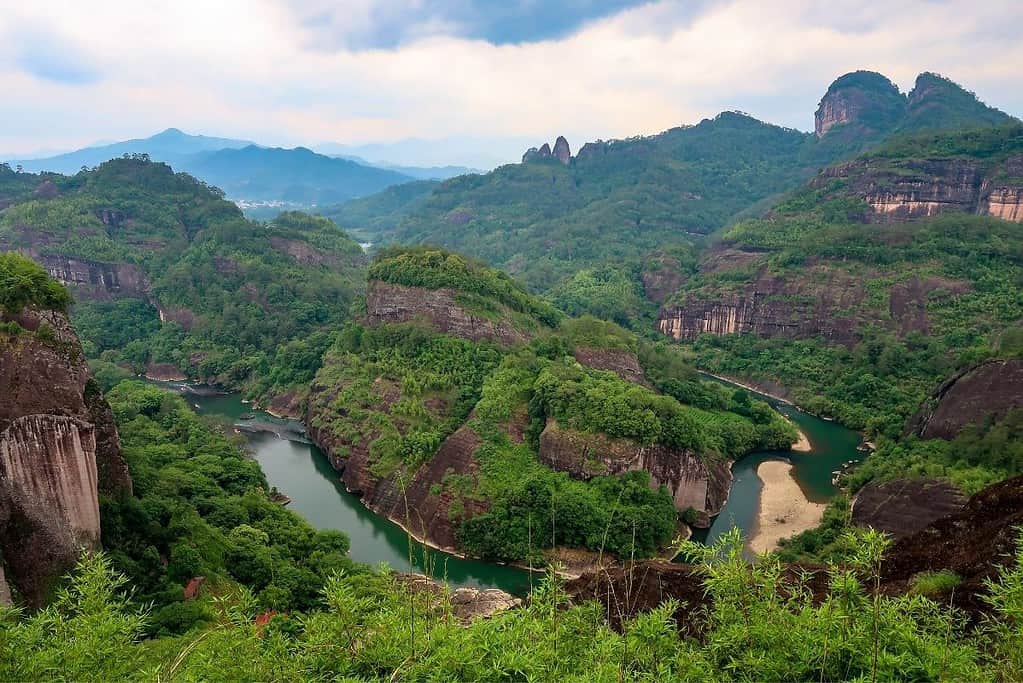
Mount Wuyi, a UNESCO World Heritage Site in China, is a breathtaking natural wonder renowned for its stunning landscapes and rich cultural heritage. Nestled in the Fujian Province, this majestic mountain range is famous for its dramatic cliffs, deep valleys, and pristine forests that cover its slopes. Mount Wuyi is a visual marvel and holds immense historical and spiritual significance. It has been a center for Confucianism, Taoism, and Buddhism, with numerous temples, monasteries, and ancestral halls dotting its terrain. The area is also known for its exceptional biodiversity, housing rare plant and animal species. Whether you’re an adventurer, a nature lover, or a cultural enthusiast, a visit to Mount Wuyi promises an unforgettable experience that blends natural beauty with profound cultural heritage.
China UNESCO tentative list
- Dongzhai Port Nature Reserve
- The Alligator Sinensis Nature Reserve
- Poyang Nature Reserve
- The Lijiang River Scenic Zone at Guilin
- Yalong, Tibet
- Yangtze Gorges Scenic Spot
- Jinfushan Scenic Spot
- Heaven Pit and Ground Seam Scenic Spot
- Hua Shan Scenic Area
- Yandang Mountain
- Nanxi River
- Maijishan Scenic Spots
- Wudalianchi Scenic Spots
- Haitian Scenic Spots
- Dali Chanshan Mountain and Erhai Lake Scenic Spot
- Sites for Liquor Making in China
- Ancient Residences in Shanxi and Shaanxi Provinces
- City Walls of the Ming and Qing Dynasties
- Slender West Lake and Historic Urban Area in Yangzhou
- The Ancient Waterfront Towns in the South of the Yangtze River
- Chinese Section of the Silk Road: Land routes in Henan Province, Shaanxi Province, Gansu Province, Qinghai Province, Ningxia Hui Autonomous Region, and Xinjiang Uygur Autonomous Region; Sea Routes in Ningbo City, Zhejiang Province and Quanzhou City, Fujian Province – from Western-Han Dynasty to Qing Dynasty
- Fenghuang Ancient City
- Site of Southern Yue State
- Baiheliang Ancient Hydrological Inscription
- Miao Nationality Villages in Southeast Guizhou Province: The villages of Miao Nationality at the Foot of Leigong Mountain in the Miao Ling Mountains
- Karez Wells
- Expansion Project of Imperial Tombs of the Ming and Qing Dynasties: King Lujian’s Tombs
- The Four Sacred Mountains as an Extension of Mt. Taishan
- Taklimakan Desert—Populus euphratica Forests
- China Altay
- Karakorum-Pamir
- The Central Axis of Beijing (including Beihai)
- Wooden Structures of Liao Dynasty—Wooden Pagoda of Yingxian County,Main Hall of Fengguo Monastery of Yixian County
- Sites of Hongshan Culture: The Niuheliang Archaeological Site, the Hongshanhou Archaeological Site, and the Weijiawopu Archaeological Site
- Ancient Porcelain Kiln Site in China
- SanFangQiXiang
- Ancient Tea Plantations of Jingmai Mountain in Pu’er
- Western Xia Imperial Tombs
- Dong Villages
- Lingqu Canal
- Diaolou Buildings and Villages for Tibetan and Qiang Ethnic Groups
- Archaeological Sites of the Ancient Shu State: Site at Jinsha and Joint Tombs of Boat- shaped Coffins in Chengdu City, Sichuan Province; Site of Sanxingdui in Guanghan City, Sichuan Province 29C.BC-5C.BC
- Xinjiang Yardang
- Dunhuang Yardangs
- Tianzhushan
- Jinggangshan–North Wuyishan (Extension of Mount Wuyi)
- ShuDao
- Tulin-Guge Scenic and Historic Interest Areas
- The Chinese Section of the Silk Roads
- Guancen Mountain — Luya Mountain
- Hulun Buir Landscape & Birthplace of Ancient Minority
- Qinghai Lake
- The scenic and historic area of Sacred Mountains and Lakes
- Taihang Mountain
- Vertical Vegetation Landscape and Volcanic Landscape in Changbai Mountain
- Imperial Kiln Sites of Jingdezhen
- Badain Jaran Desert—Towers of Sand and Lakes
- Huangguoshu Scenic Area
- Guizhou Triassic Fossil Sites
- The Coast of the Bohai Gulf and the Yellow Sea of China
- Hainan Tropical Rainforest and the Traditional Settlement of Li Ethnic Group
- Fujian Minjiang River Estuary: The ecotone between marine and terrestrial biogeographical regions
Tours in China
Our choices of tours in China are divided into thematic features such as Beijing, Xi’an, and The Great Wall of China Experience.
